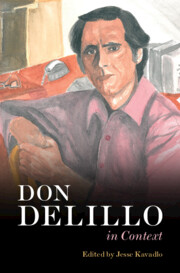Book contents
- Don DeLillo In Context
- Don DeLillo In Context
- Copyright page
- Contents
- Contributors
- Acknowledgments
- Abbreviations
- Introduction: Context, Content, Conflict
- Part I Places
- Part II History and Politics
- Part III Media and Pop Culture
- Part IV Literary Contexts
- Part V Material Contexts
- Part VI Social and Cultural Constructions
- Chapter 24 Religion and Spirituality
- Chapter 25 Race
- Chapter 26 Ethnicity
- Chapter 27 Gender
- Chapter 28 Time
- Part VII Writing and Writers
- Further Reading
- Index
- References
Chapter 28 - Time
Still Life
from Part VI - Social and Cultural Constructions
Published online by Cambridge University Press: 19 May 2022
- Don DeLillo In Context
- Don DeLillo In Context
- Copyright page
- Contents
- Contributors
- Acknowledgments
- Abbreviations
- Introduction: Context, Content, Conflict
- Part I Places
- Part II History and Politics
- Part III Media and Pop Culture
- Part IV Literary Contexts
- Part V Material Contexts
- Part VI Social and Cultural Constructions
- Chapter 24 Religion and Spirituality
- Chapter 25 Race
- Chapter 26 Ethnicity
- Chapter 27 Gender
- Chapter 28 Time
- Part VII Writing and Writers
- Further Reading
- Index
- References
Summary
While DeLillo’s entire oeuvre has been concerned with the exigencies and mysteries of time as it is shaped by human hands into history, time seems to saturate the pages of his more recent works in a new, immersive way, prompting us to consider more carefully art’s capacity to reflect, influence, and challenge not only what we choose to do with the time we have, but our methods of measuring it.
- Type
- Chapter
- Information
- Don DeLillo In Context , pp. 270 - 280Publisher: Cambridge University PressPrint publication year: 2022



